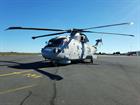FLYING TIGERS GET CLAWS INTO NATO SUBMARINE EXERCISE
The game is on again for the Navy’s premier submarine hunters as they spend a fortnight in the Mediterranean keeping underwater foes in check.
The Flying Tigers of 814 Naval Air Squadron are once again Britain’s representatives at NATO’s annual test of anti-submarine forces staged in the Ionian Sea.
Nine nations – Canada, France, Germany, Greece, Spain, Turkey, Britain, the USA plus hosts Italy – have thrown their hats into the ring for the two-week-long Exercise Dynamic Manta.
Assisted by eight surface ships and five long-range maritime patrol aircraft, the Merlin Mk2 from Culdrose has five submarines to find lurking in the waters east and south of Catania in Sicily.
It took three days for the helicopter to hop across Europe to reach Sigonella air base in the shadow of Mount Etna, a 1,330-mile journey which took the Merlin via Bordeaux, St Tropez and Sardinia.
A 20-strong team of aircrew (each sortie requires two pilots, one observer and one aircrewman), supported by 40 engineers, technical staff, weather forecasters, safety and logistics experts, will take the fight to the foe until March 6.
The Culdrose Merlin – equipped with sonobuoys (listening devices dropped in the ocean), a ‘dipping sonar’ (lowered to pinpoint a submarine’s position), a flying ‘operations room’ (run by the observer and aircrewman) and Sting Ray torpedoes/depth charges – will lead the aerial hunt alongside the Italians’ variant of the helicopter.
Manta is one of NATO’s two annual sub hunts, focused on finding boats in warmer waters (later in the year Dynamic Mongoose is hosted off Norway).
The temperature of the sea (as well as salinity and various temperature layers) play a key role in how effective sonar is. Right now it’s about 15C – a good 5C warmer than the waters off 814’s native Lizard Peninsula.
The exercise isn’t purely about hunting submarines; it’s a test for the boats to evade the helicopters, frigates and sonobuoys trying to locate them and conduct mock attacks on the surface ships.
Rear Admiral Andrew Burcher, in charge of NATO submarine operations, said the fortnight-long war game remained “one of the most challenging exercises – and an excellent opportunity for NATO nations’ naval forces to practise and evaluate their anti-surface and anti-submarine warfare skillset in a challenging environment.”
The skills the fliers will hone over the next fortnight will keep them at the top of their game - vital as the Merlins are a key part of the ring of steel protecting both the UK's nuclear deterrent submarines and the HMS Queen Elizabeth/Prince of Wales carrier strike groups from the threat posed by hostile submarines.

